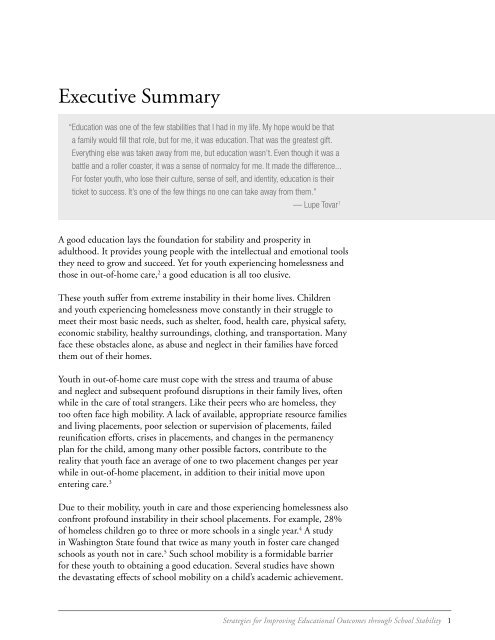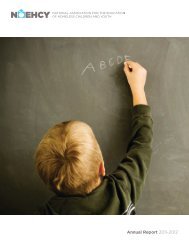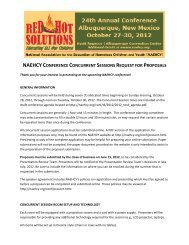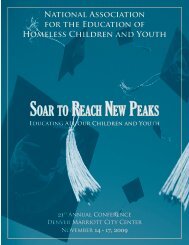The McKinney-Vento Act and Children and Youth ... - State of Michigan
The McKinney-Vento Act and Children and Youth ... - State of Michigan
The McKinney-Vento Act and Children and Youth ... - State of Michigan
You also want an ePaper? Increase the reach of your titles
YUMPU automatically turns print PDFs into web optimized ePapers that Google loves.
Executive Summary<br />
“ Education was one <strong>of</strong> the few stabilities that I had in my life. My hope would be that<br />
a family would fill that role, but for me, it was education. That was the greatest gift.<br />
Everything else was taken away from me, but education wasn’t. Even though it was a<br />
battle <strong>and</strong> a roller coaster, it was a sense <strong>of</strong> normalcy for me. It made the difference...<br />
For foster youth, who lose their culture, sense <strong>of</strong> self, <strong>and</strong> identity, education is their<br />
ticket to success. It’s one <strong>of</strong> the few things no one can take away from them.”<br />
— Lupe Tovar 1<br />
A good education lays the foundation for stability <strong>and</strong> prosperity in<br />
adulthood. It provides young people with the intellectual <strong>and</strong> emotional tools<br />
they need to grow <strong>and</strong> succeed. Yet for youth experiencing homelessness <strong>and</strong><br />
those in out-<strong>of</strong>-home care, 2 a good education is all too elusive.<br />
<strong>The</strong>se youth suffer from extreme instability in their home lives. <strong>Children</strong><br />
<strong>and</strong> youth experiencing homelessness move constantly in their struggle to<br />
meet their most basic needs, such as shelter, food, health care, physical safety,<br />
economic stability, healthy surroundings, clothing, <strong>and</strong> transportation. Many<br />
face these obstacles alone, as abuse <strong>and</strong> neglect in their families have forced<br />
them out <strong>of</strong> their homes.<br />
<strong>Youth</strong> in out-<strong>of</strong>-home care must cope with the stress <strong>and</strong> trauma <strong>of</strong> abuse<br />
<strong>and</strong> neglect <strong>and</strong> subsequent pr<strong>of</strong>ound disruptions in their family lives, <strong>of</strong>ten<br />
while in the care <strong>of</strong> total strangers. Like their peers who are homeless, they<br />
too <strong>of</strong>ten face high mobility. A lack <strong>of</strong> available, appropriate resource families<br />
<strong>and</strong> living placements, poor selection or supervision <strong>of</strong> placements, failed<br />
reunification efforts, crises in placements, <strong>and</strong> changes in the permanency<br />
plan for the child, among many other possible factors, contribute to the<br />
reality that youth face an average <strong>of</strong> one to two placement changes per year<br />
while in out-<strong>of</strong>-home placement, in addition to their initial move upon<br />
entering care. 3<br />
Due to their mobility, youth in care <strong>and</strong> those experiencing homelessness also<br />
confront pr<strong>of</strong>ound instability in their school placements. For example, 28%<br />
<strong>of</strong> homeless children go to three or more schools in a single year. 4 A study<br />
in Washington <strong>State</strong> found that twice as many youth in foster care changed<br />
schools as youth not in care. 5 Such school mobility is a formidable barrier<br />
for these youth to obtaining a good education. Several studies have shown<br />
the devastating effects <strong>of</strong> school mobility on a child’s academic achievement.<br />
Strategies for Improving Educational Outcomes through School Stability 1














